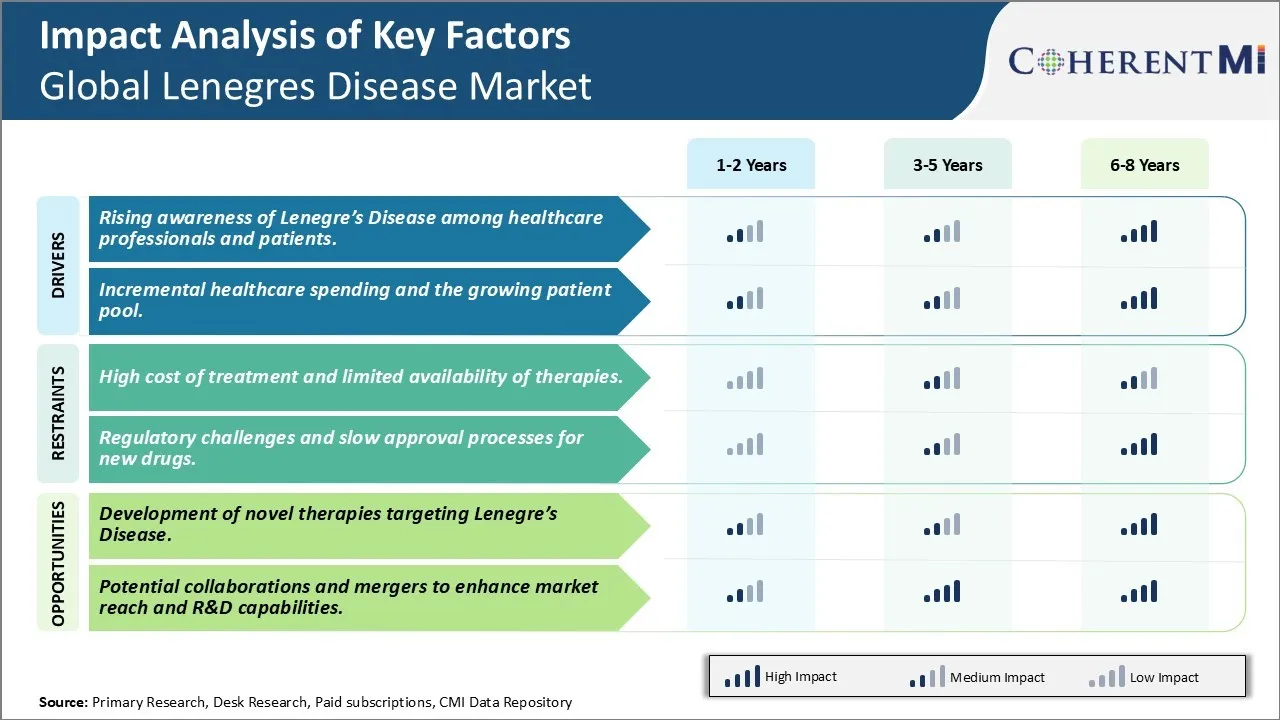Lenegres Disease Market Trends
Market Driver - Rising awareness of Lenegre’s Disease among healthcare professionals and patients.
Awareness of Lenegre’s disease has increased significantly in the recent years among both healthcare professionals and patients. Various educational campaigns conducted by patient advocacy groups and non-profit organizations have played a crucial role in enhancing the understanding of this condition. Several renowned cardiologists and electrophysiologists have also taken initiative in educating other physicians about the symptoms, diagnosis and management of Lenegre’s disease. This has helped in early identification of more number of cases.
Previously, Lenegre’s disease was often misdiagnosed as some other cardiac condition due to lack of awareness. But now, even general physicians and cardiologists in primary care have fair knowledge about this disease. They are able to detect subtle symptoms and signs of Lenegre’s disease and refer high-risk patients to specialty care timely. Furthermore, with growing digitization in the healthcare industry, resources about Lenegre’s disease have become widely available online. Patients can easily access informative articles, videos and discussion forums to learn more about their condition. This has empowered them to participate actively in medical decisions.
The patient communities on social media platforms have also played a significant role in raising awareness. Patients share their experiences and spread knowledge which reach out to a broad audience. Others who may have similar symptoms are now more informed to discuss the possibility of Lenegre’s disease with their doctors. All these efforts towards creating awareness have increased the rate of accurate diagnosis and prevented delays in treatment initiation. With more patients being diagnosed, the need for advanced diagnostic modalities and management options continues to rise.
Incremental Healthcare Spending and the Growing Patient Pool
The rising healthcare expenditure on cardiology indicates greater financial allocation for treating cardiac conditions including Lenegre’s disease. Governments across different countries have increased their healthcare budgets recognizing the growing burden of cardiovascular illnesses. This has provided impetus to research into novel diagnostic tools, drugs and treatment protocols. More funding opportunities are being created to encourage pharmaceutical and device manufacturing companies to develop products specific to rare heart conditions like Lenegre’s disease.
At the same time, the total number of Lenegre’s disease patients is surging owing to the aging global population prone to develop the disease. Furthermore, the pandemic has highlighted the need to focus on cardiovascular health more vigorously. It is estimated that there will be over 50% rise in the geriatric population susceptible to Lenegre’s disease in the next couple of decades. More patients would require long-term clinical management, medications, implantable devices and procedures. This expanding patient population augment the demand for specialized services and drives the need for continued investments in research.
The rising investments and growing patient numbers work in tandem to fuel the market size. Governments are allocating higher public health expenditures while more patients require advanced care generating greater revenuepotential for the market. Both government and private sector are thus expected to pump in increased funding to develop new diagnostics, drugs and treatment solutions matching the emerging needs. This willingness to spend more on quality healthcare opens fruitful opportunities for companies in this industry.

Market Challenge - High cost of treatment and limited availability of therapies.
One of the major challenges faced by the global Lenegre’s disease market is the high cost of treatment and limited availability of approved therapies. Lenegre’s disease is a rare genetic disorder with no approved disease-modifying treatments currently available. The few treatment options that exist mostly focus on managing symptoms and improving quality of life, but do not target the underlying causes or progression of the disease. This makes treatment extremely expensive in the long run for patients. Moreover, the rare nature of the disease means that pharmaceutical companies have little incentive to invest heavily in research and development of new treatments. This has resulted in very few therapies in the clinical pipeline for Lenegre’s disease. The limited competition in the market allows companies to charge very high prices for the few treatments that are available, placing an immense financial burden on patients, healthcare systems and governments. Overall, the high cost of existing symptomatic therapies combined with the lack of curative options poses a major challenge to growth of the global Lenegre’s disease market.
Market Opportunity: Development of Novel Therapies Targeting Lenegre’s Disease
One of the biggest opportunities in the global Lenegre’s disease market lies in the development of novel therapies that specifically target the underlying pathological mechanisms and progression of the disease. Recently, advancements in understanding the genetics and biological pathways involved in Lenegre’s disease have enabled researchers to identify several potential new therapeutic targets. A number of biotech and pharmaceutical companies have started exploring these targets for developing transformative disease-modifying treatments. Some of the modalities under research include gene therapies, RNA-based therapies and innovative protein therapies. If successful, these novel targeted therapies can potentially halt or reverse the effects of Lenegre’s disease rather than just managing symptoms. This will represent a major clinical advancement with benefits like reducing long-term healthcare costs and improving quality of life for patients. It also provides a large commercial opportunity for the first companies to develop and launch effective curative therapies for Lenegre’s disease. Overall, the market remains optimistic about the promising pipeline of novel targeted treatments for this condition.